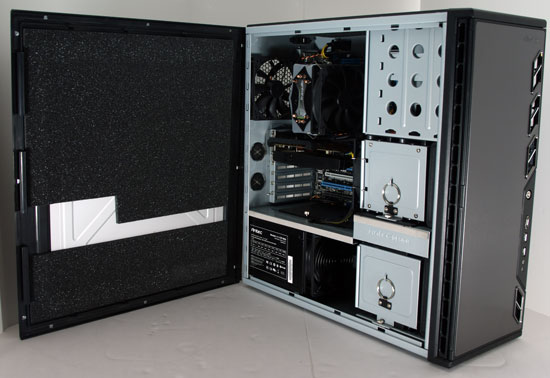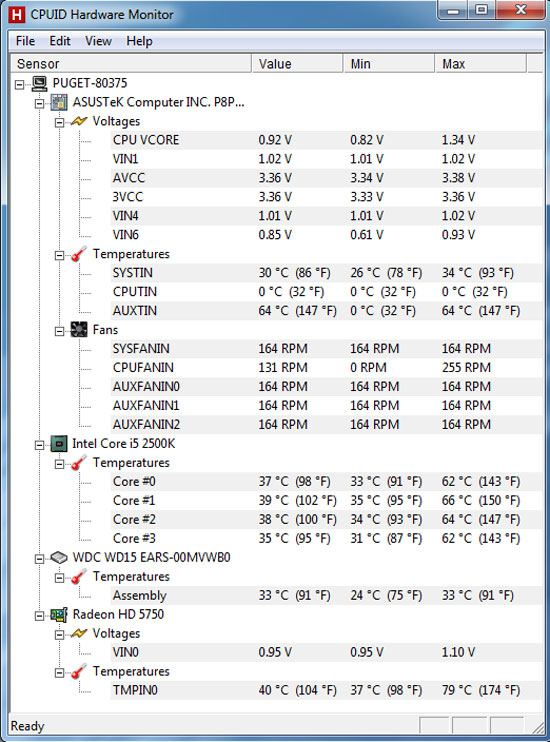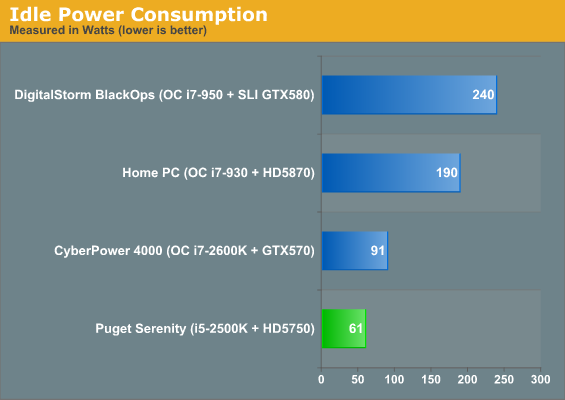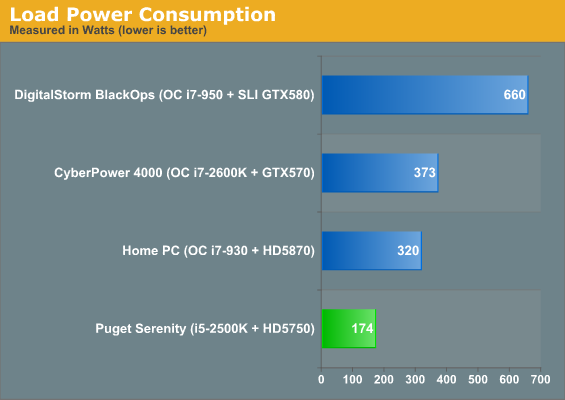Puget Systems Serenity SPCR Edition: Blissful Silence
by Dustin Sklavos on February 10, 2011 12:00 AM EST- Posted in
- Systems
- Intel
- Radeon
- Sandy Bridge
- Puget Systems
- Serenity SPCR
Build, Noise, Heat, and Power Consumption
Given the somewhat exotic nature of Puget Systems's Serenity SPCR Edition tower, it's reasonable to assume that there just aren't any good corners to cut. I'm happy to report that, having examined the system, Puget Systems simply couldn't and didn't.
What makes the build particularly interesting compared to the others is that, as I mentioned in the introduction, this really is a custom build, not just a melange of carefully chosen and assembled parts. Take a look inside and see what I mean.

Seeing the additional foam padding on the inside of the side panel when I had to remove the internal packing was a major cue, and the foam has been carefully cut to fit around the internals of the Antec P183 case used for the build. From the photo you can see three major points in Puget Systems's favor: quality case, quality power supply, and additional custom sound dampening. What's harder to see is that Puget Systems removed the Antec Tricool fans from the case and replaced them with silent Scythe 120mm fans. They've also bracketed an additional fan to the top hard drive tray, and they've removed the top exhaust fan and covered the vent with foam.
Another interesting point is the use of an air cooler instead of a watercooling system on the processor. I've reviewed more desktops with watercoolers than not and they're generally considered among the quietest ways to go, but here Puget Systems opts to use an air cooler—the Gelid Tranquilo—with a silent fan. They also carefully tuned the fan speeds in the ASUS board's UEFI to ensure silent running.
Certainly building the entire system for low noise is going to mean running a little hotter than normal, though, right? Interestingly, that's not the case.

Check out those thermals. The Serenity SPCR Edition keeps everything running remarkably frosty, and that's due in no small part to the attention paid to airflow inside the case. The P183 was already an excellent case with great thermals (we actually have a review unit on hand and we'll be posting a case review in the coming months), but the modified cooling produces airflow moving in effectively a straight line through the tower with minimal turbulence, allowing the fans to run at low speeds without compromising thermal performance. Even the Radeon doesn't crack 80C.
With those temperatures and the system's configuration in mind, these power consumption figures should come as no surprise to you:


We tested power consumption by idling at the desktop, and then running our Left 4 Dead 2 timedemo. In my experience, very few games are capable of pulling as much power from a system as Left 4 Dead 2 can. Something about the Source engine's relatively frugal usage of graphics hardware lets the processor and video power consumption scale well together.
Under load, Puget Systems's Serenity SPCR Edition draws less power than my fairly frugal desktop does at idle. Sandy Bridge has proven to be stunningly power efficient in the testing we've been able to do (we really can't wait to get our hands on more Sandy Bridge-equipped notebooks), and combining that with the already efficient Radeon HD 5750 keeps power consumption low. The next system up on the list—my home tower—draws nearly twice as much power under load. That increase in power draw may be commensurate with the increase in gaming performance, but keep in mind the i5-2500K is able to handle processor-intensive tasks much more efficiently than the i7-930.
















139 Comments
View All Comments
pcfxer - Thursday, February 10, 2011 - link
RTA analysis + anechoic chamber time = engineering.They hand picked the fans, coolers, etc. to work together based on what they believed to be appropriate compromises.
Let's take your simpleton description to another analogy.
"Engineering? They took some bolts, some plastic, motor oil, a few sensors to fit inside a mustang body! Damn them and their highly efficient 5.0L with more horsepower than a base Corvette!"
Like I said, some of you just don't get what Engineering is.
FunBunny2 - Thursday, February 10, 2011 - link
Don't be so quick to jump on that bandwagon. OCZ has been getting a lot of heat over its Vertex 2 parts built with 25nm NAND. A topic you should pursue, by the way.bigbob123456 - Thursday, February 10, 2011 - link
Speaking from experience, I can tell you that's the most half-assed foam installation. First that's a cheap medium density foam. Quality would mean using 1/4" neoprene, which costs 3x as much as what they used. Second, they're making a mistake in cutting slots in the foam for the structure of the case...it's FOAM it'll compress to compensate. Third, they could have used 3x as much foam as they did. I see lots of exposed metal at the back of the case, around the motherboard, on the drive cage, etc.I recently bought some foam and did my own installation, and every square inch you cover beyond just the front / sides does make an audible difference. In a lot of places I even doubled up on the foam.
HangFire - Thursday, February 10, 2011 - link
"I recently bought some foam and did my own installation, and every square inch you cover beyond just the front / sides does make an audible difference."Wow, impressive. So how much lower than 11db did you get? And how is it you could actually hear the difference below 11db? Are you an Owl?
Or maybe... once PS got to 11db... they knew they could stop right there?
bigbob123456 - Thursday, February 10, 2011 - link
Obviously I did my own installation in a normal game box, subjectively cutting the noise level in half. The point is it speaks to the level of overpricing on this machine given the quality (lack of) they put into it. For example, if they would have done some better foaming they probably could have thrown in a 6870 or something instead of a useless 5750 and had the same results. Duh.HangFire - Tuesday, February 15, 2011 - link
Puget Sound does make gaming systems. Anandtech didn't review of them them. D'oh.MeanBruce - Thursday, February 10, 2011 - link
I guess you can purchase a PC like this one and let someone else decide and define a silent PC for you. But for $2200 you can build a much quieter and much higher performing and much better looking PC than this Puget. Corsair AX850 is a much better psu than this Antec, Noctua NH-D14 is a much better CPU cooler than the Gelid, and the Asus 6870 direct cu is a much better video choice than the 5770. Do some research put some time into it learn a great deal and pay yourself in better components instead of paying Pugit for assembly costs!Wrap all these great parts in a Corsair Obsidian 650D enclosure and run the 6870 fan on auto. It's 10decibels of hardware heaven! Enclose your hardware not your mind!
PartEleven - Thursday, February 10, 2011 - link
I think you have no idea how quiet 10 db really is. The system you described is no where near 10 db.kevith - Thursday, February 10, 2011 - link
You're absolutely right: 10 dB is VERY little sound.MeanBruce - Thursday, February 10, 2011 - link
Oh I know 10db and 8db and 6db. Read my earlier comments on each component, this article. Maybe you are not up on the latest heatsinks by Asus they are huge allowing fans to run at idle 15 percent and stay in the 30s. I know the fan can also produce 30db but I am talking idle and working in Office apps, not gonna argue but the AX850 is dead silent fan does not move under 25percent load and the Noctua NH-D14 I run with no fans passive! Don't assume until you really know!